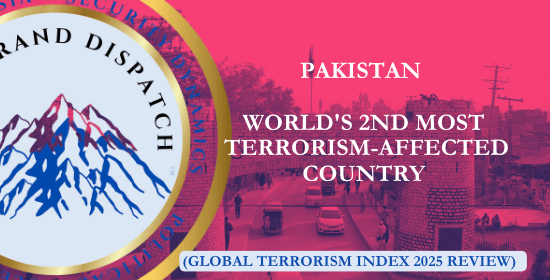Pakistan Now Ranks as World's 2nd Most Terrorism-Affected Country
(Global Terrorism Index, 2025 Review)
The newly released Global Terrorism Index (GTI) 2025 reinforces a growing reality: Pakistan is facing its most severe terrorism crisis since 2014, now ranking as the second most terrorism-affected country globally. Pakistan experienced a 45% increase in terrorism deaths, rising to 1,081 in 2024, while terrorist attacks more than doubled from 517 to 1,099. This marks the fifth consecutive year of increased terrorist activity, overlapping with the Taliban's return to power in neighboring Afghanistan. The western provinces of Balochistan and Khyber Pakhtunkhwa account for over 96% of terrorist activity, with the Afghanistan border regions seeing the most significant deterioration. The most affected districts include North and South Waziristan, Bannu, and Dera Ismail Khan.
Tehrik-i-Taliban Pakistan (TTP) The TTP has emerged as Pakistan's primary security challenge and the third deadliest terrorist group globally. Our review points to three critical developments:
Unprecedented Activity Levels: TTP attacks increased by over 100% in the past year, with deaths rising 90% to 558. This surge represents one of TTP's highest activity levels since 2011.
Expanding Tactical Capabilities: The group has notably increased its use of bombing attacks (300% rise year-on-year) while maintaining armed assaults as a key tactic. Improved IED technology and more coordinated attacks potentially suggest additional training and support.
Security Force Targeting: Police forces bear the brunt of TTP violence, representing 51% of all attack targets. The strategy of targeting police forces is not unique to the TTP, however, and is often used by groups to undermine local governance while avoiding direct confrontation with better-equipped military units.
The Baloch Insurgency Factor While TTP dominates headlines, the Balochistan Liberation Army (BLA) and Balochistan Liberation Front (BLF) have intensified their campaigns against Pakistani security forces and infrastructure projects. Per the report, attacks by these groups increased from 116 in 2023 to 504 in 2024, with deaths surging over fourfold to 388. The November 2024 bombing at Quetta railway station, demonstrating the BLA's continued ability to execute high-profile attacks. Chinese nationals and China-Pakistan Economic Corridor (CPEC) projects remain primary targets, with strategic implications for Pakistan-China relations.
The Afghanistan Connection Despite dropping to ninth place in the Global Terrorism Index, Afghanistan's internal dynamics continue to directly influence Pakistan's security environment. Three factors deserve particular attention:
Taliban-TTP Relationship: Despite official denials, substantial evidence indicates ongoing operational support between the Afghan Taliban and TTP.
Islamic State Khorasan Province Evolution: The GTI 2025 identifies ISKP as a critical threat that has expanded beyond Afghanistan into Pakistan, Iran, Russia, and Central Asia. In 2024, ISK was linked to two of the year's deadliest attacks globally - the January attack in Kerman, Iran (95 deaths) and the March attack in Moscow, Russia (144 deaths). The group has become more deadly outside Afghanistan than within, highlighting its transnational evolution. ISK produces sophisticated multilingual propaganda and leverages advanced technology, including AI and cryptocurrency, despite lacking significant territorial control.
Border Management Challenges: Pakistan's attempts to secure the Afghanistan-Pakistan border through fencing have been repeatedly contested by Taliban forces, with several border clashes reported in late 2024.
Outlook for 2025 The report suggests Pakistan's security environment will likely worsen before it improves. Three scenarios deserve monitoring:
Escalation Scenario: Intensified TTP attacks trigger more aggressive Pakistani military responses, including deeper incursions into Afghanistan, heightening tensions with the Taliban regime.
Negotiation Path: Economic constraints and military limitations push Pakistan toward renewed peace talks with TTP, though previous negotiations have consistently failed.
Regional Approach: Growing recognition of shared threats leads to improved counterterrorism cooperation between Pakistan, Afghanistan, and Central Asian states, possibly facilitated by China or Russia.
The most likely outcome combines elements of escalation and negotiation, with Pakistani security forces intensifying operations in key TTP strongholds while government intermediaries explore potential political compromises.


